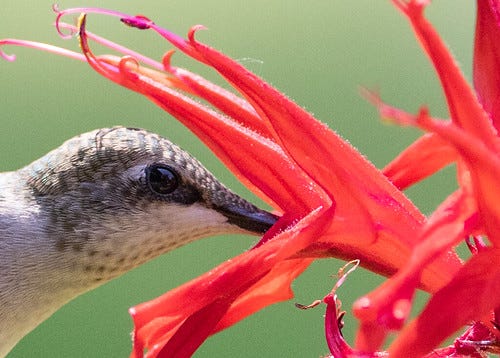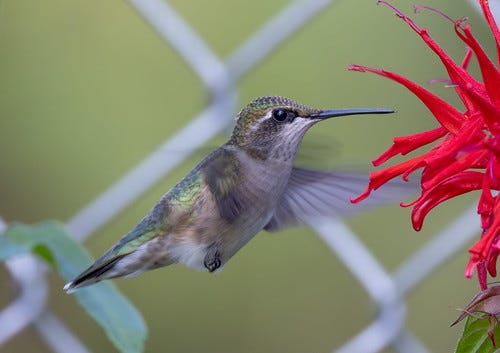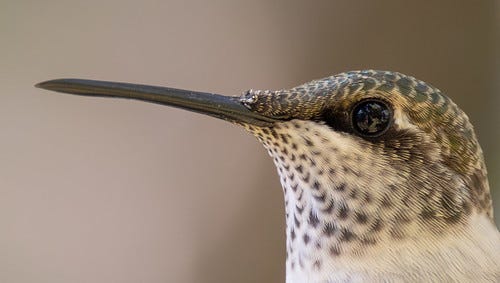Ruby-throated Hummingbird Migration
Even more miraculous than we used to think
(Listen to the radio version here.)
For a long time, conventional wisdom had it that people in the eastern half of the continent should always bring in their hummingbird feeders by Labor Day or we’d tempt Ruby-throated Hummingbirds to linger too long during migration. That never made sense to me, and indeed, most hummingbird experts always disputed it. During migration, most hummingbirds are on the move from morning till night, feeding along the way whenever they spot flowers or feeders. One may linger a day or two in a spot with abundant food after a few days of slim pickin’s, when it needs to build up its weight again, but unless necessary, they don’t waste time this far north so late in their migration season.
Even when hummingbirds appear to be spending a lot of time at our feeders, they get most of their food from natural sources. Non-stop action at feeders usually involves considerably more hummingbirds than we’d guess. As late as September 14, I was seeing at least 3 different Ruby-throats, which I could confirm by seeing two in a chase even as a third sat in a tree or a feeder. I would bet that if I could distinguish individuals, those “3” were actually at least a dozen seen most of those days.
September 14 is over a week later than I usually see so many—most years I’ve brought in all but one or two hummingbird feeders before September 10th after going several days without seeing any, or just single birds feeding and moving on. Some combination of this year's unique weather, air quality, and vegetation conditions probably caused this exceptionally late migration, but climate change is almost certainly impacting and probably extending their nesting season in the north.
Another bit of conventional wisdom that I repeated for decades is that in late summer, Ruby-throated Hummingbirds virtually all head straight for the Gulf Coast, pig out, and then strike out over the Gulf straight for the Yucatán Peninsula, heading from there to wherever in Central America they will spend the winter. As hard as it is to believe that a bird weighing in at an eighth or even a tenth of an ounce could possibly fly non-stop for 500 miles, for generations it was even harder for scientists to imagine that a bird with such an incredibly tiny brain could make changes in its route south based on wind, precipitation, food availability, and other factors. I learned in two ornithology classes in the 70s that their migration path was hard-wired in their tiny brains. You'd think I'd know better.
All kinds of studies have confirmed that many Ruby-throated Hummingbirds gather in the Yucatán in late winter and early spring and, after building up their weight, fly non-stop over the Gulf to the U.S. Studies of hummingbirds that alight on oil rigs during fall migration indicate that at least some take an over-water route in autumn, too, but the southward migration is much more complicated than ornithologists once believed.
As hummingbird authority Sheri Williamson wrote in 2020:
The Yucatan Peninsula may be a convenient launching point for birds headed north from Central America, but this narrow wedge of land would be a tricky target for southbound birds. A migrant whose course is off by just a few degrees east would end up out over the open Caribbean, with few dots of land for rest and refuge. A westward drift could add more than 200 miles to the journey, severely testing the limits of the birds’ endurance and fuel storage.
On her blog post describing what is actually true about Ruby-throat migration based on sound data, Sheri Williamson used an eBird visualization, an animated map showing Ruby-throated Hummingbird abundance over the course of the year based on eBird reports. Ruby-throats are essentially absent from the Yucatán from the end of May through November each year but grow incredibly abundant there in March and April, indicating that the Yucatán is an important part of their spring migration route but hardly used at all in autumn. The visualization showing abundance shifts over their annual cycle is a wonderful thing—you should check it out!
Sheri Williamson also cites a research project on the Alabama coast:
The study found that juvenile Ruby-throateds use overland routes around the Gulf rather than crossing it, and that departure timing from stopover sites (locations where migrating birds rest and refuel) was correlated with wind direction, with a significant preference for winds from the east rather than the north. Adults were rarely encountered at the study’s coastal site, leading the researcher to speculate that experienced migrants took off across the Gulf from points farther inland. Given the scarcity of early fall sightings on the Yucatan Peninsula, it’s far more plausible that the vast majority of adult Ruby-throateds are also taking overland routes, though apparently farther inland than inexperienced juveniles.
Sheri Williamson suggests that the few Ruby-throated Hummingbirds that do end up on the Yucatán in autumn are more likely to have arrived there from Florida.
As we take our final looks at the last of this year’s Ruby-throated Hummingbirds in the coming days, it’s lovely to remember that the sparkle of intelligence in their eyes isn’t just our imagination. These tiny jewels truly are individuals worth reckoning with.







Thank you, Laura. Your posts are always enlightening and beautifully written. And as a Brit, eyeing anything hummingbird-related with consuming envy, I have a particular fascination for the subject.